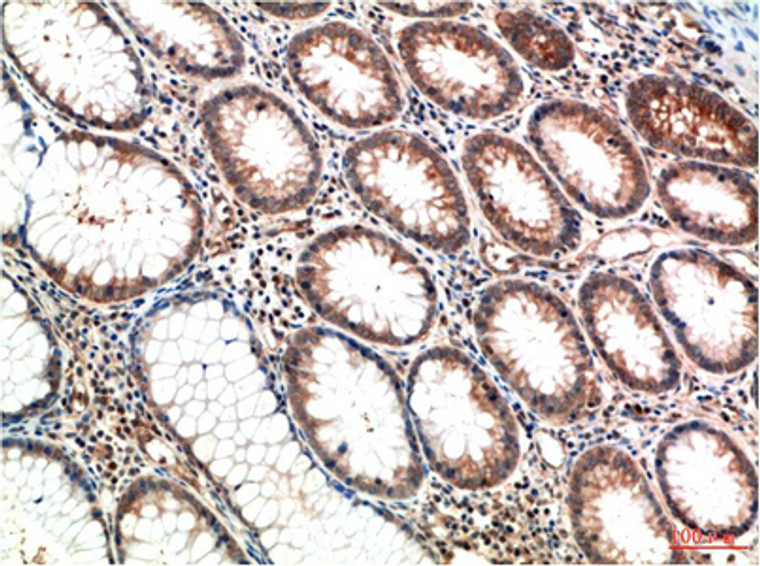| Host: |
Mouse |
| Applications: |
IHC/IF |
| Reactivity: |
Human/Rat/Mouse |
| Note: |
STRICTLY FOR FURTHER SCIENTIFIC RESEARCH USE ONLY (RUO). MUST NOT TO BE USED IN DIAGNOSTIC OR THERAPEUTIC APPLICATIONS. |
| Short Description: |
Mouse monoclonal antibody anti-Serine-protein kinase ATM is suitable for use in Immunohistochemistry and Immunofluorescence research applications. |
| Clonality: |
Monoclonal |
| Clone ID: |
1D1 |
| Conjugation: |
Unconjugated |
| Isotype: |
IgG1 |
| Formulation: |
Liquid in PBS containing 50% Glycerol, 0.5% BSA and 0.02% Sodium Azide. |
| Purification: |
The antibody was affinity-purified from mouse ascites by affinity-chromatography using specific immunogen. |
| Concentration: |
1 mg/mL |
| Dilution Range: |
IHC 1:100-200IF 1:50-200 |
| Storage Instruction: |
Store at-20°C for up to 1 year from the date of receipt, and avoid repeat freeze-thaw cycles. |
| Gene Symbol: |
ATM |
| Gene ID: |
472 |
| Uniprot ID: |
ATM_HUMAN |
| Specificity: |
ATM protein detects endogenous levels of ATM |
| Immunogen: |
Recombinant Protein of ATM of ATM |
| Post Translational Modifications | Phosphorylated by NUAK1/ARK5. Autophosphorylation on Ser-367, Ser-1893, Ser-1981 correlates with DNA damage-mediated activation of the kinase. During the late stages of DNA damage response, dephosphorylated following deacetylation by SIRT7, leading to ATM deactivation. Acetylation, on DNA damage, is required for activation of the kinase activity, dimer-monomer transition, and subsequent autophosphorylation on Ser-1981. Acetylated in vitro by KAT5/TIP60. Deacetylated by SIRT7 during the late stages of DNA damage response, promoting ATM dephosphorylation and subsequent deactivation. |
| Function | Serine/threonine protein kinase which activates checkpoint signaling upon double strand breaks (DSBs), apoptosis and genotoxic stresses such as ionizing ultraviolet A light (UVA), thereby acting as a DNA damage sensor. Recognizes the substrate consensus sequence ST-Q. Phosphorylates 'Ser-139' of histone variant H2AX at double strand breaks (DSBs), thereby regulating DNA damage response mechanism. Also plays a role in pre-B cell allelic exclusion, a process leading to expression of a single immunoglobulin heavy chain allele to enforce clonality and monospecific recognition by the B-cell antigen receptor (BCR) expressed on individual B-lymphocytes. After the introduction of DNA breaks by the RAG complex on one immunoglobulin allele, acts by mediating a repositioning of the second allele to pericentromeric heterochromatin, preventing accessibility to the RAG complex and recombination of the second allele. Also involved in signal transduction and cell cycle control. May function as a tumor suppressor. Necessary for activation of ABL1 and SAPK. Phosphorylates DYRK2, CHEK2, p53/TP53, FBXW7, FANCD2, NFKBIA, BRCA1, CTIP, nibrin (NBN), TERF1, UFL1, RAD9, UBQLN4 and DCLRE1C. May play a role in vesicle and/or protein transport. Could play a role in T-cell development, gonad and neurological function. Plays a role in replication-dependent histone mRNA degradation. Binds DNA ends. Phosphorylation of DYRK2 in nucleus in response to genotoxic stress prevents its MDM2-mediated ubiquitination and subsequent proteasome degradation. Phosphorylates ATF2 which stimulates its function in DNA damage response. Phosphorylates ERCC6 which is essential for its chromatin remodeling activity at DNA double-strand breaks. Phosphorylates TTC5/STRAP at 'Ser-203' in the cytoplasm in response to DNA damage, which promotes TTC5/STRAP nuclear localization. Also involved in pexophagy by mediating phosphorylation of PEX5: translocated to peroxisomes in response to reactive oxygen species (ROS), and catalyzes phosphorylation of PEX5, promoting PEX5 ubiquitination and induction of pexophagy. |
| Protein Name | Serine-Protein Kinase AtmAtaxia Telangiectasia MutatedA-T Mutated |
| Database Links | Reactome: R-HSA-2559586Reactome: R-HSA-3371453Reactome: R-HSA-349425Reactome: R-HSA-5685938Reactome: R-HSA-5685942Reactome: R-HSA-5693548Reactome: R-HSA-5693554Reactome: R-HSA-5693565Reactome: R-HSA-5693568Reactome: R-HSA-5693571Reactome: R-HSA-5693579Reactome: R-HSA-5693607Reactome: R-HSA-5693616Reactome: R-HSA-6796648Reactome: R-HSA-6803204Reactome: R-HSA-6803207Reactome: R-HSA-6804756Reactome: R-HSA-6804757Reactome: R-HSA-6804760Reactome: R-HSA-69473Reactome: R-HSA-69541Reactome: R-HSA-912446Reactome: R-HSA-9664873Reactome: R-HSA-9701192Reactome: R-HSA-9704331Reactome: R-HSA-9704646Reactome: R-HSA-9709570Reactome: R-HSA-9709603 |
| Cellular Localisation | NucleusCytoplasmic VesicleCytoplasmCytoskeletonMicrotubule Organizing CenterCentrosomePeroxisome MatrixPrimarily NuclearFound Also In Endocytic Vesicles In Association With Beta-AdaptinTranslocated To Peroxisomes In Response To Reactive Oxygen Species (Ros) By Pex5 |
| Alternative Antibody Names | Anti-Serine-Protein Kinase Atm antibodyAnti-Ataxia Telangiectasia Mutated antibodyAnti-A-T Mutated antibodyAnti-ATM antibody |
Information sourced from Uniprot.org
12 months for antibodies. 6 months for ELISA Kits. Please see website T&Cs for further guidance







![Western blot analysis of lysates from wild type (WT) and ATM knockout (KO) 293T cells, using [KO Validated] ATM Rabbit polyclonal antibody (STJ11100214) at 1:500 dilution. Secondary antibody: HRP Goat Anti-Rabbit IgG (H+L) (STJS000856) at 1:10000 dilution. Lysates/proteins: 25 Mu g per lane. Blocking buffer: 3% nonfat dry milk in TBST. Detection: ECL Enhanced Kit. Exposure time: 180s. Western blot analysis of lysates from wild type (WT) and ATM knockout (KO) 293T cells, using [KO Validated] ATM Rabbit polyclonal antibody (STJ11100214) at 1:500 dilution. Secondary antibody: HRP Goat Anti-Rabbit IgG (H+L) (STJS000856) at 1:10000 dilution. Lysates/proteins: 25 Mu g per lane. Blocking buffer: 3% nonfat dry milk in TBST. Detection: ECL Enhanced Kit. Exposure time: 180s.](https://cdn11.bigcommerce.com/s-zso2xnchw9/images/stencil/300x300/products/89282/357792/STJ11100214_1__91923.1713121979.jpg?c=1)